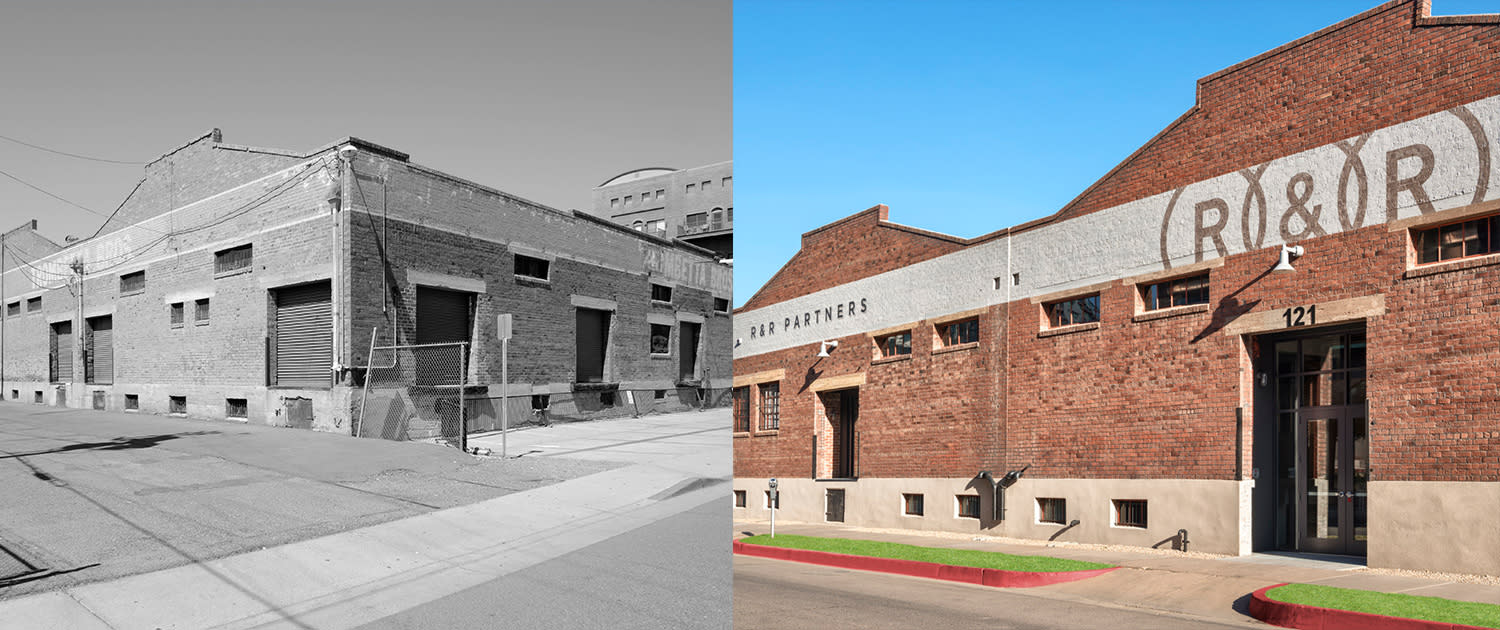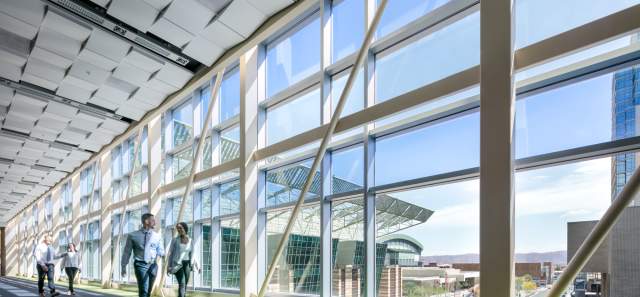Find out why this revitalized neighborhood may be downtown Phoenix's best-kept secret.
Steeped in generations of history, downtown Phoenix's Warehouse District is a neighborhood that's often overlooked — despite a burst of revitalization in recent years. Located immediately south of the downtown core, this once-forgotten downtown neighborhood has blossomed into a burgeoning adaptive reuse district that's home restaurants, bars, venues, galleries, eclectic tech and coworking spaces and, of course, the nearby sports stadiums.
To become reacquainted with this eclectic trove of art and architecture, I've snagged an adventurous friend or two to accompany me on urban forays — we’ve seen works by Richard Serra and Anish Kapoor, two giants of the art world, heard a reggae band from Colorado, eaten trendy mac n cheese muffins and had a master mixologist craft us a perfect homage to this city.
The History
Back to Top of List The 1930 Ong Yut Geong Wholesale Market building has been restored and occupied by its owners, R&R Partners.
The 1930 Ong Yut Geong Wholesale Market building has been restored and occupied by its owners, R&R Partners.
The Warehouse District — bounded roughly by Jefferson Street (north) and Buckeye Road (south), 7th Street to 7th Avenue east to west) — is the last frontier in Phoenix, says architect Brian Cassidy, principal of CCBG Architects, Inc. and chair of the Warehouse District Council, a coalition of neighborhood business owners.
“We were the lone rangers down here,” says Cassidy of his firm’s decision to build its three-story office and studio in the district in 2005. “It was pretty much just us down here when it came to businesses.”
Cassidy and his partners were drawn to the district for its just-steps-away proximity to the downtown core, history and stock of virtually untouched character buildings.
"This area developed in the late 1800s and early 1900s as the city’s warehouse center,” Cassidy explains. The 1887 addition of the railroad, which traversed the Warehouse District, brought many changes to the city.
“Most of the streets had railroad spurs to the warehouses that moved products and produce. The buildings, which were built from the 1800s through the 1940s, were done dock height to accommodate horse-drawn wagons, trains and trucks. After World War II, Phoenix experienced suburban flight, and a lot of the activity here dwindled. Some of the warehouses were leveled, but this neighborhood has one of the best collections of historic brick and concrete buildings in the state."
The district was home to many minority communities, including the city’s earliest Chinatown, Mexican-American neighborhoods and Phoenix Union Colored High School — which still stands today as The George Washington Carver Museum and Cultural Center. Take a look at some of the buildings then and now.
“There are more and more businesses moving down here, especially co-work, creative and tech companies," Cassidy says. “The light rail will have a southern extension right through the heart of the Warehouse District, and there are proposals to do more housing here. The future here is a great mix of old and new.”
Today's Art Scene
Back to Top of List
After decades of languishing, the district crept back to life in the 1990s when local artists discovered that these warehouses offered inexpensive studio space. Artist studios still dot the neighborhood, but the district was put on the art world's map when Bentley Calverley opened Bentley Gallery in 2004, in part of a 28,000-square-foot red brick building built in 1918 as a commercial laundry.
“I needed a place where I could show big pieces,” says Calverley, who started her career as a gallerist in Philadelphia and New York in the early 1970s. “My former gallery in Scottsdale couldn’t accommodate 18-foot-tall sculptures or 24-foot-long paintings.”
Over the years, she’s focused on contemporary, abstract works from mid-career or established artists, showing or representing works by internationally acclaimed artists, such as Jim Dine, Jun Kaneko, Philip Moulthrop and the afore-mentioned Serra and Kapoor. Calverley also champions local and emerging artists, and has given use of her building adjacent to the main gallery as artist studios.
I like to lurk in the gallery, contemplating the sometimes-hidden meanings in the art and admiring the building’s architecture, with its brick walls and exposed beam ceilings. Bentley Gallery has regular hours, new shows monthly and is a featured participant in Art Detour, the annual March open house of downtown galleries and studios.
Since 2014, Arizona State University’s School of Art has been transforming a 42,000-square-foot former machine shop into its Grant Street Studios, which houses more than 60 studios for MFA students working in everything from painting and sculpture to fiber, ceramics, 3-D printing and photography. The raw, industrial building, which, on its Seventh Street facade, is completely covered with metal traffic signs, also includes the Step Gallery, where grad students exhibit their thesis shows, and Northlight Gallery, a place for photography students to exhibit their images. Northlight, established originally on ASU’s Tempe campus, also hangs works by renowned photographers—recent shows have included works by Edward Curtis and Minor White.
“ASU wanted to be part of the Warehouse District,” says Northlight’s curator Liz Allen, “and part of the downtown Phoenix arts and culture scene, the building is perfect for us.”
Grant Street Studios is also perfect if you’re looking to add some art from talented local students to your collection. Some (not all) of the art shown in exhibitions is for sale. Both galleries have regular, albeit limited, hours during the academic year (late summer through early spring) and are also open during First Friday and Third Friday art walks.
Dining, Nightlife & More
Back to Top of List
Visual art isn’t the only form of culture in the district. If you like your music indie and your music venues intimate, head to Last Exit Live, a cozy spot where you’re never more than a few feet from the stage. The emphasis is on local and regional talent, but nationally touring bands also check in. Spruced up recently with an expanded patio and glass garage doors that make for an indoor-outdoor experience, Last Exit Live is where we had a few beers and caught that reggae band. Insider tip: The crowds don’t start to arrive until after 10 p.m.
Some people can live on art and music alone. Me? I like to try innovative culinary creations and indulge in an adult beverage or two.
The Warehouse District delivers on both fronts, offering up both old-school basics and menus that appeal to influencers of the foodie variety.
The family-owned La Canasta restaurant opened in 1962 and spawned a wholesale Mexican food business (think: tortillas, chips, salsas). The original eatery serves up menudo, tamales, bean- and cheese-topped sopapillas, plus Mexican menu standards — not to mention margaritas.
When on the hunt for street tacos, though, I head to a newer place, Sonora Taco Shop, with counter service and inside seating for maybe 10. They offer carne asada, al pastor and pollo tacos, all grilled to order, plus vampiros–a corn tortilla grilled to crispness and topped with beans and cheese. The name? A bit of a mystery, but maybe it’s for late-night vampires who chow down on the crunchy delights after the clubs have closed. And, yes, you can find Mexican Coke in the cooler.
Another Phoenix pillar is Lo-Lo’s Chicken and Waffles. Easy to spot with its mural-clad exterior, this is the flagship of the White family's southern-fried chicken empire (meet Mrs. White and discover her original restaurant concept, which is just a few blocks away). At Lo-Lo's, however, breakfast is served all day and hood classics include a variety of combinations of chicken, waffles, grits, eggs, mac and cheese, and other deliciousness.
The Duce, a newer restaurant/bar/gym/club/store/event space, is paean to multipurposeness. The brainchild of Andi and Steve Rosenstein, who bought an old brick produce warehouse (hence The Duce) in 2007 with the idea of doing something cool with it. The couple — founders of the Fitigues fashion line — outfitted the 16,000-square-foot space with a vintage bar, an Airstream trailer that now houses the kitchen, an old soda fountain, a boxing ring and even bleachers from St. Mary's High School. You can grab a meal (beer can chicken is another specialty), get a cocktail, indulge in a spiked milkshake and shop for merch that includes home accessories and branded tees. Need to move around? Ping pong tables, corn hole and foosball are for those who can’t sit still. Swing and salsa dance classes happen on weeknights, and on Sunday mornings, you can join in a boot camp-style workout that ends with a mimosa.
When I need those perfect martinis and crafted cocktails, I make a pilgrimage to Bitter & Twisted Cocktail Parlour, the city’s internationally recognized cocktail parlor that was founded by Ross Simon, a Scottsman who has driven Arizona’s cocktail resurgence (check out his favorite places to grab a cocktail). It’s housed in the 1920s Art Deco Luhrs building, which, ironically enough was once the Prohibition headquarters for the state. Belly up to the long bar or grab a tall booth and peruse the vast cocktail menu to find a classic or new-creative drink to your taste. The Asian-influenced food menu goes beyond wings and sliders, with such offerings as spicy burgers served on ramen buns and Korean nachos.
Venues & Hotels
Back to Top of List
Both the unique buildings and central location of this area have made it a natural fit for events of all varieties. Weddings and gallery shows are mainstays for locals. But the abundance of adaptive reuse spaces in such close proximity to the Phoenix Convention Center (a half mile or 2-3 city blocks), and accessible via the Valley Metro Rail, has caught the attention of corporate event planners — and aesthetically appealing, indoor-outdoor spaces continue to trend as the perfect canvas for branding large-scale soirées of every kind.
The Icehouse, a venue known for hosting performing arts, music, special events and creative installations, actually used to produce 300-pound blocks of ice to keep produce cold as it was shipped out of town via railroad. Today, the breathtaking venue regularly hosts events — that range from inventive community dinners by Cloth & Flame to the debut of a massive, a fire-breathing "FeNyx,” a collaboration between metal sculptor Sean T. French and Epic Works Artists — in its roofless Cathedral Room.
The Croft Downtown comprises 10,000 square feet of luxurious event space, including two rooms that let out on to their own patios and a private, outdoor lawnscape — the addition of which made it possible for this venue to play host to a open-air candlelight concert series throughout 2020. Then, in 2021, Michelangelo's "Sistine Chapel Exhibition" transformed the space into yet another immersive experience for all.
Billed as an alternative to meeting in a boardroom, Events on Jackson offers meeting rooms and advanced technology by day. Once business has concluded, expect the garage doors to roll out of the way so the space can morph into a vibrant social scene for the evening.
As for hotels, if you're looking for a place to stay for the duration of an itinerary that includes any or all of the places we covered, Courtyard by Marriott Phoenix Downtown or Residence Inn by Marriott Phoenix Downtown share a building directly next to the Warehouse District. Upon opening in 2017, the 320-room and suite hotel combines two Marriott concepts in one sleek, stylish and modern 19-story tower that offers prime views of the warehouses, as well as Chase Field and Footprint Center. Best news? Ross Simon and fellow cocktail-ologist Aaron DeFeo are the masterminds behind Little Rituals, the hotel’s bar that you can find perched on the fourth floor.
I order “Big City Lights,” a sour with gin, vermouth with herbal notes, a layer of egg white topped with rice paper that serves as a canvas for the miniature version of the bar's famous photo op: A mural tribute to the city's past. There isn't a more perfect way to end this day. Cheers!
Editor's Picks
Things to do in Downtown Phoenix
From arts and culture, to dining and nightlife, pro sports and more, we highlight what to do in the…
First Friday Art Walk
Experience one of the nation's largest self-guided art walks on the First Friday of every month in…
Greater Phoenix Hotels with Must-See Murals
We’ve all heard the term “a room with a view,” but how about accommodations with a vibrant local…







